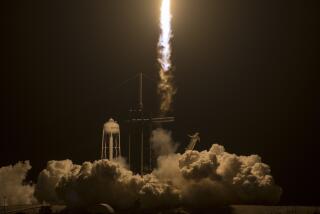Magellan’s Mapping of Venus Threatened by Transmitter Problems : Space: Main device has failed and backup is overheating. However, the craft has completed much of its task.
- Share via
Engineers at NASA’s Jet Propulsion Laboratory are scrambling to circumvent problems with faulty transmitters aboard the spacecraft Magellan that threaten to end the historic effort to map the entire surface of Venus.
Magellan’s primary transmitter failed Saturday and cannot be repaired. The balance of the mission hangs on a backup transmitter that tends to overheat and may not be able to transmit many more images from the spacecraft, officials said Tuesday. Magellan is about one year into its two-year mission.
Although Magellan has mapped about 95% of the planet’s surface, scientists at the Pasadena lab had hoped to fill in gaps in the coverage and remap the entire surface so that they could detect active geological processes. They had hoped, for example, to find evidence of current volcanic eruptions by comparing recent images with those taken a year earlier.
But that goal is in serious jeopardy because of problems with the two transmitters, lab officials said.
Project manager Jim Scott said there is no way to regain use of the primary transmitter because the failure is within the transmitter itself and cannot be repaired from the ground.
The backup transmitter overheats, producing a “spurious signal” that “corrupts” the transmission to Earth, Scott said. He said engineers are trying to stabilize the temperature in hopes of using that transmitter to finish Magellan’s work.
“There’s a good chance we will find a way to use the second transmitter,” he said.
If not, it will be a serious disappointment to scientists who had hoped to combine several images of the same scenes to produce three-dimensional images of the surface of Venus.
The $450-million spacecraft has completed 3,880 orbits of Venus, and it had more than completed its primary mission of mapping 70% of the planet with a radar camera that penetrates the dense clouds that block the view of the surface. The images are the sharpest ever taken of Venus, but scientists had hopped for thousands of additional pictures to better study a planet that started out much like the Earth, but ended up much different.
This weekend, Scott said, engineers will crank up the backup transmitter and try to make it work. If they fail, the pictures will stop coming, but Magellan will still be able to send back some scientific data.
The spacecraft was scheduled to begin studying the planet’s gravitational field this fall, and that should still be possible, Scott said.
More to Read
Sign up for Essential California
The most important California stories and recommendations in your inbox every morning.
You may occasionally receive promotional content from the Los Angeles Times.












